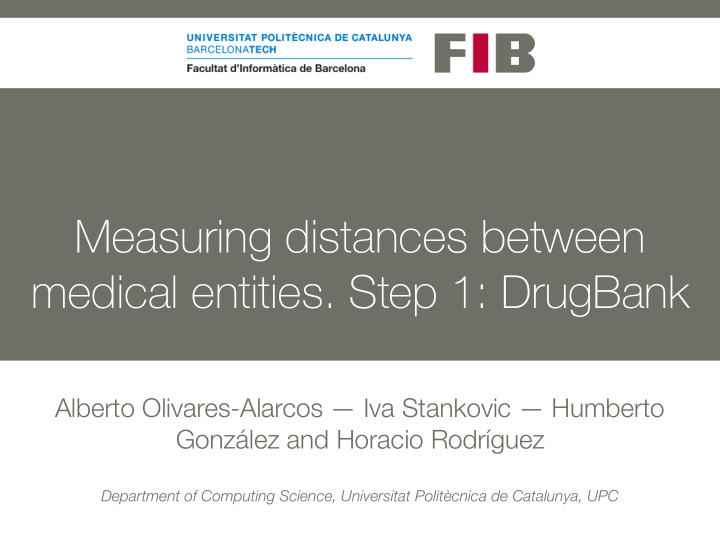



Measuring distances between medical entities. Step 1: DrugBank Alberto Olivares-Alarcos — Iva Stankovic — Humberto González and Horacio Rodríguez Department of Computing Science, Universitat Politècnica de Catalunya, UPC
Abstract We face in this paper the problem of computing distance measures between medical entities. Specifically we deal with the most challenging type of medical entity: drugs. Three different similarity measures between drugs are presented, based each one on specific dimensions of drugs description, namely textual, taxonomic and molecular information. All the information has been extracted from the same resource, the DrugBank database Evaluation Clustering Similarities have been used to cluster the drugs into groups. Then, we studied the ATC Code distribution of those clusters in order to check if our similarity measurements are good Ground Truth The similarity of a list of 100 pairs of drugs was annotated by experts. We have taken it from [Franco et al., 2014] and modified and adapted to our convenience [Franco et al., 2014] Franco, P., Porta, N., Holliday, J. D., and Willett, P. (2014). The use of 2d fingerprint methods to support the assessment of structural similarity in orphan drug legislation. Journal of Cheminformatics, 6(1):5. Overview
Contributions • Novel text based similarity over DrugBank • Qualitative indirect evaluation based on clustering • Novel taxonomy based similarity over DrugBank • Quantitative direct evaluation using a small ground • Molecular Structure based similarity over DrugBank truth • Three similarity measurements within the same • MIT License Code provided on a GitHub repository framework ( Python ) Conclusions Three different similarity measurement over drugs from DrugBank have been implemented:textual, taxonomic and molecular. To our knowledge theres is no other work which includes these three measures within the same framework. A evaluation of the implemented similarities has been performed by means of both indirect (Clustering) and direct (Ground Truth) evaluation. The Clustering evaluation has provided lights and shadows, while in some cases we have been able to cluster properly the drugs based on their ATC Codes, we have not in several cases. This does not strongly implies our similarity measures are not good. Spectral Clustering, used in this work, and graph-based semi-supervised learning algorithms, in general, are well known to be sensitive to how graphs are constructed from data. In particular if the data has proximal and unbalanced clusters these algorithms can lead to poor performance. On the other hand, some promising results have been found in the evaluation based on the ground truth, specially, for the similarity based on Molecular Structure. Nevertheless, the results are not definitive, a need of a larger ground truth is clear. Conclusion
Recommend
More recommend